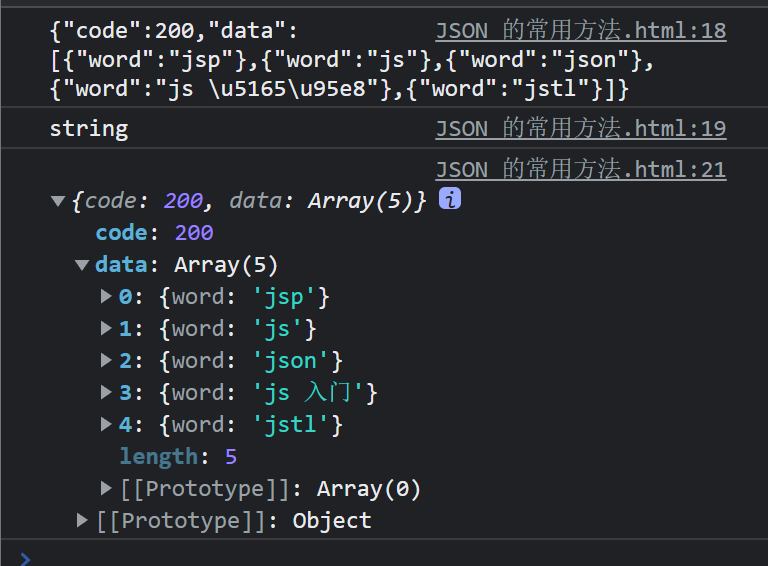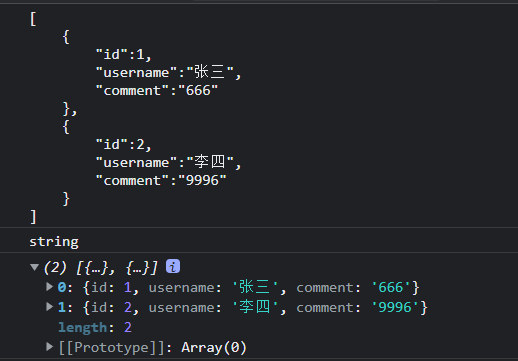JSON 的常用方法
JSON.parse()
console.log(JSON.parse(xhr.responseText));

console.log(JSON.parse(xhr.responseText).data);

<!DOCTYPE html>
<html>
<head>
<meta charset="utf-8">
<title>JSON 的常用方法</title>
</head>
<body>
<script>
//1.JSON.parse()
//JSON.parse()可以将JSON格式的字符串解析成js中的对应值
//一定要是合法的JSON字符串,否则会报错
const xhr =new XMLHttpRequest();
xhr.onreadystatechange = () =>{
if(xhr.readyState!== 4) return;
if(xhr.status>= 200&&xhr.status < 300 ||xhr.status===304){
console.log(xhr.responseText);
console.log(typeof xhr.responseText)
console.log(JSON.parse(xhr.responseText));
/* console.log(JSON.parse(xhr.responseText).data); */
}
};
//xhr.open('GET','./json/plain.json',true);
xhr.open('GET','./json/arr.json',true);
/* xhr.open('GET','https://www.imooc.com/api/http/search/suggest?words=js',true); */
xhr.send(null);
</script>
</body>
</html>

JSON.stringify()

使用JSON.parse()和JSON.stringify()封装localStorage
<!DOCTYPE html>
<html>
<head>
<meta charset="utf-8">
<title>JSON 的常用方法</title>
</head>
<body>
<script type="module">
//1.JSON.parse()
//JSON.parse()可以将JSON格式的字符串解析成js中的对应值
//一定要是合法的JSON字符串,否则会报错
// const xhr =new XMLHttpRequest();
// xhr.onreadystatechange = () =>{
// if(xhr.readyState!== 4) return;
// if(xhr.status>= 200&&xhr.status < 300 ||xhr.status===304){
// console.log(xhr.responseText);
// console.log(typeof xhr.responseText)
// console.log(JSON.parse(xhr.responseText));
// /* console.log(JSON.parse(xhr.responseText).data); */
// }
// };
// //xhr.open('GET','./json/plain.json',true);
// xhr.open('GET','./json/arr.json',true);
// /* xhr.open('GET','https://www.imooc.com/api/http/search/suggest?words=js',true); */
// xhr.send(null);
//2.JSON.stringify()
//JSON.JSON.stringify()可以JS的基本数据类型、对象或者数组
//转换成JSON格式的字符串
/* console.log(JSON.stringify({
uusername:'alex',
age:18,
})
); */
/* const xhr = new XMLHttpRequest();
xhr.open('post','https://www.imooc.com/api/http/search/suggest?words=js',true);
xhr.send(
JSON.stringify({
username:'alex',
age:18,
})
); */
//3.使用JSON.parse()和JSON.stringify() 封装
localStorage
import{get,set,remove,clear} from './js/storage.js';
set('username','nmb');
console.log(get('username'));
set('nmb2.0',{
name:'那么棒',
age:18
});
console.log(get('nmb2.0'));
remove('username');
clear();
</script>
</body>
</html>



初识跨域
跨域是什么
<!DOCTYPE html>
<html>
<head>
<meta charset="utf-8">
<title>初始跨域</title>
</head>
<body>
<script>
//1.跨域是什么
//同域,不是跨域
//const url = './index.html';
// const url = 'https://www.baidu.com';//不同域
// const xhr = new XMLHttpRequest();
/* Access to XMLHttpRequest at 'https://www.baidu.com/' from origin 'http://127.0.0.
1:8848' has been blocked by CORS policy: No 'Access-Control-Allow-Origin' header is
present on the requested resource.
*/
//想一个域发送请求,如果请求的域和当前与是不同域,就要跨域
//不同域之间的请求,就是跨域请求
// xhr.onreadystatechange = () => {
// if (xhr.readyState != 4) return;
// if ((xhr.status >= 200 && xhr.status < 300) || xhr.status === 304) {
// console.log(xhr.responseText);
// }
// };
// xhr.open('GET', url, true);
// xhr.send(null);
</script>
</body>
</html>

2.什么事不同域,什么是同域
https(协议)://www.imooc.com(域名):443(端口号)/course/list(路径)
协议、域名、端口号、任何一不一样无所谓
不同域
https://www.imooc.com:443/course/list
https://www.imooc.com:80/course/list
http://www.imooc.com:80/course/list
http://m.imcco.com:80/course/list
http:/imcco.com:80/course/list
同域
htpp://imooc.com:80
htpp://imooc.com:80/course/list
跨域请求为什么会被阻止
阻止跨域请求,其实是浏览器本的一种安全策略--同源策略
其他客户端或者服务器都不存在跨域被阻止的问题
跨域解决方案
CORS跨域资源共享
优先使用CORS跨域资源共享,如果浏览器不支持CORS的话,再使用JSONP